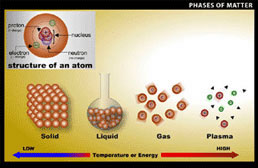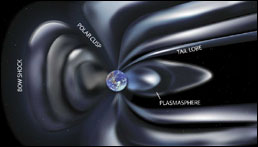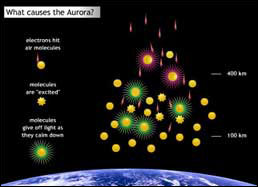We rely on the Sun's energy to live on Earth and the aurora relies on the Sun's energy to drive the currents that make the aurora. The Sun is our nearest star. It is, as all stars are, a hot ball of gas made up mostly of Hydrogen. The Sun is so hot that most of the gas is actually plasma, the fourth state of matter.
 The first state is a solid and it is the coldest state of matter. As we heat up a solid it becomes liquid. Liquid is the second state of matter. As we heat up liquid, the liquid turns to gas. Gas is the third state of matter. As we heat up the gas, atoms break apart into charged particles turning the gas into plasma. This is not the same type of plasma that is found in your blood: same name, different stuff.
The first state is a solid and it is the coldest state of matter. As we heat up a solid it becomes liquid. Liquid is the second state of matter. As we heat up liquid, the liquid turns to gas. Gas is the third state of matter. As we heat up the gas, atoms break apart into charged particles turning the gas into plasma. This is not the same type of plasma that is found in your blood: same name, different stuff.
The Sun's plasma is so hot that the most energetic charged particles can escape from the Sun's gravity and fly away, out into space. We call this plasma the solar wind because it blows out away from the Sun and past the planets, interacting with their magnetic fields and/or atmospheres. Along with the solar wind comes the Sun's magnetic field, which reaches from the Sun out to past Pluto and Neptune.
 Charged particles and magnetic fields influence each other. So when the solar wind, which is made up of charged particles, blows past Earth's magnetosphere, the shape of the magnetic field changes from the dipole magnetic field -- shown on Earth's Magnetosphere page -- to a plasma-swept magnetosphere that looks more like someone's hair got blown in the wind. This interaction between the Sun's plasma wind and Earth's magnetosphere is known as the Sun-Earth Connection.
Charged particles and magnetic fields influence each other. So when the solar wind, which is made up of charged particles, blows past Earth's magnetosphere, the shape of the magnetic field changes from the dipole magnetic field -- shown on Earth's Magnetosphere page -- to a plasma-swept magnetosphere that looks more like someone's hair got blown in the wind. This interaction between the Sun's plasma wind and Earth's magnetosphere is known as the Sun-Earth Connection.
The side of the magnetosphere getting hit by the solar wind is called the "dayside magnetosphere" because it is facing the Sun. The part of the magnetosphere that stretches back as though it were streaming with the solar wind is called the magnetotail. The magnetotail is very important to the THEMIS mission.
 The every day interaction between the solar wind and Earth's magnetic fields causes currents to flow between Earth's upper atmosphere and the magnetosphere, mostly the magnetotail. And just as currents flow through a neon light to light up the gas, the currents flow between the magnetotail and upper atmosphere light up Earth's gases to cause the aurora.
The every day interaction between the solar wind and Earth's magnetic fields causes currents to flow between Earth's upper atmosphere and the magnetosphere, mostly the magnetotail. And just as currents flow through a neon light to light up the gas, the currents flow between the magnetotail and upper atmosphere light up Earth's gases to cause the aurora.
 Sometimes the magnetosphere stores more energy than it can release in a slow manner and something inside the magnetotail "breaks" and waves and currents are generated that trigger the beautiful and mysterious dancing aurora that we've been talking about on these THEMIS science pages. THEMIS will solve the long standing mystery as to what triggers this energy release in the magnetotail that leads to an auroral substorm.
Sometimes the magnetosphere stores more energy than it can release in a slow manner and something inside the magnetotail "breaks" and waves and currents are generated that trigger the beautiful and mysterious dancing aurora that we've been talking about on these THEMIS science pages. THEMIS will solve the long standing mystery as to what triggers this energy release in the magnetotail that leads to an auroral substorm.



